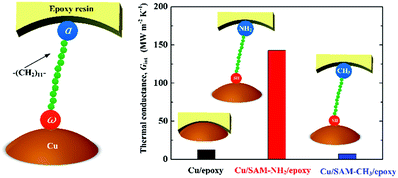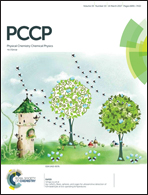Bonding-induced thermal transport enhancement across a hard/soft material interface using molecular monolayers†
Abstract
Manipulating thermal transport across hard/soft material interfaces is important for composites which are critical for a wide range of applications, including electronic packaging, thermal storage, sensors and medicine. To increase the interfacial thermal conductance (Gint), a previous strategy has focused on using a self-assembled monolayer (SAM) to bridge the phonon spectra mismatch between the materials constituting the interface. Here, we introduce a general strategy aiming for interfaces which are incompatible with the previous strategy. Copper (Cu) and epoxy resin are chosen as representative materials constituting the interface. The proposed strategy relies on using a strongly bonding SAM to covalently connect Cu and epoxy. The thermal measurements show that Gint can be enhanced by as much as 11 fold. An interesting result is found that the Cu/epoxy interface, modified with the SAM used in the previous strategy, shows approximate 2-fold lower Gint. Through a series of experiments, including tensile strength and wettability tests, the formation and characters of bonds in different interface systems are explored and understood. The correlation between bonding characters and Gint is also elucidated. We demonstrate that when the structure of the soft material is complex, interfacial thermal transport should be tuned by covalent bonds rather than by phonon spectra match. Finally, the great potential of the proposed strategy in manipulating the thermal properties of nanocomposites is illustrated here with a theoretical prediction.


 Please wait while we load your content...
Please wait while we load your content...